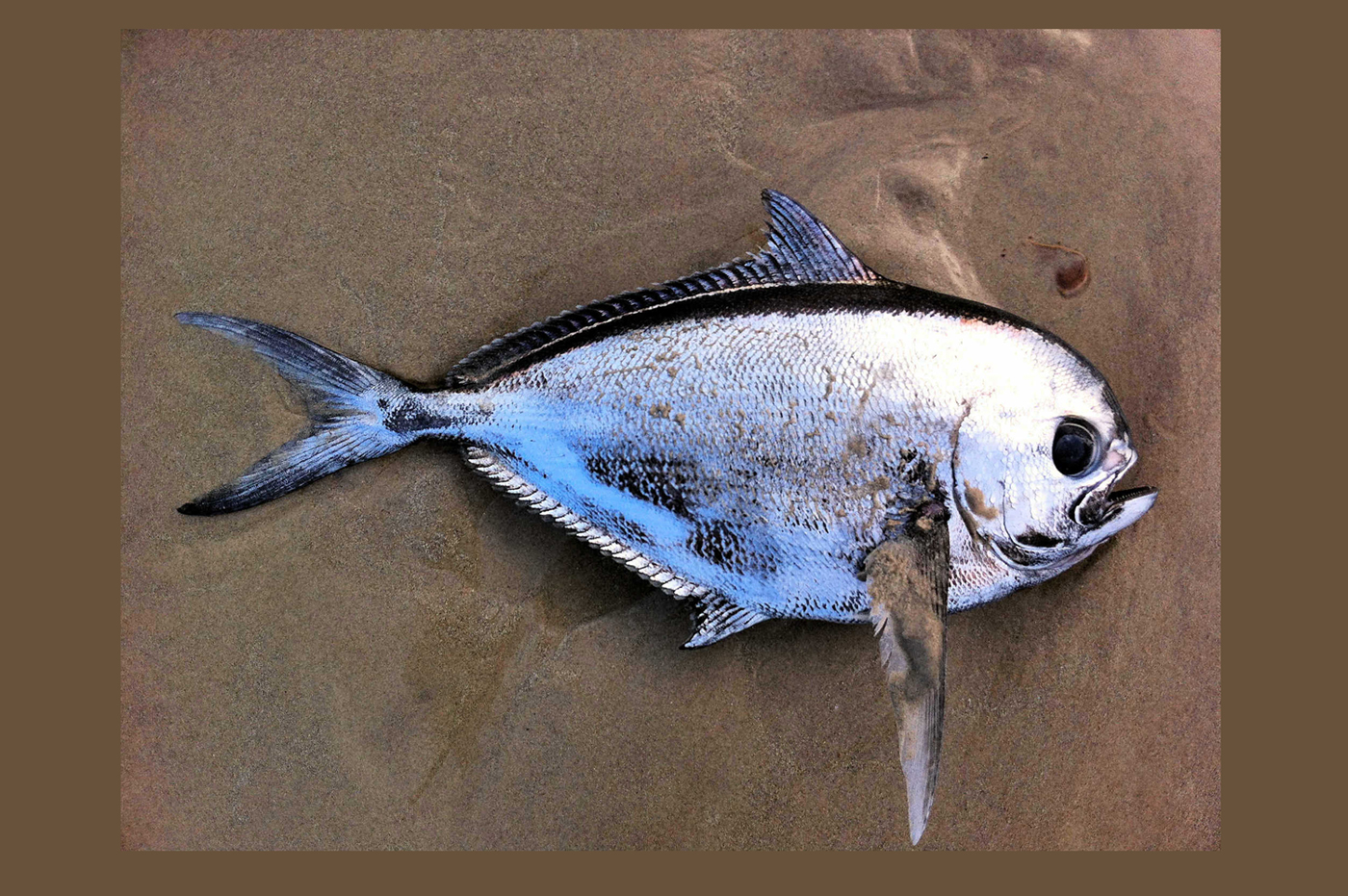Ray's Bream, Brama brama (Bonnaterre 1788)
Other Names: Atlantic Pomfret, Pomfret, Rays Bream

Ray's Bream, Brama brama, washed ashore on Sellicks Beach, South Australia, July 2015. Source: Warwick Moyse / iNaturalist.org. License: CC by Attribution-NonCommercial
Summary:
A bluish black pomfret with a silvery lustre, and large golden eyes, and a very prominently arched head profile.
Cite this page as:
Bray, D.J. 2022, Brama brama in Fishes of Australia, accessed 15 Apr 2025, https://fishesofaustralia.net.au/home/species/408
Ray's Bream, Brama brama (Bonnaterre 1788)
More Info
|
Distribution |
Off Brisbane, Queensland, around southern Australia, to off Geraldton, Western Australia, including around Tasmania; also Cocos (Keeling) Islands and Christmas Island in the eastern Indian Ocean, and the Lord Howe Province in the Tasman Sea. Elsewhere the species is circumglobal, mostly in temperate waters. Forms small schools on the Continental Slope, migrating to feed in shallower depths at night. |
|
Features |
Dorsal fin III,32–35; Anal fin II,27–30; Caudal fin 19; Pectoral fin 20–23; Pelvic fin I, 5; Gill rakers (lower limb) 8–12; Vertebrae 16–17 + 24–26 = 41–43. Body depth 40–53% SL; head length 25–29% SL, forehead prominently arched; middle of upper lip fused to head; 70–80 scales between upper end of opercle and base of mid-caudal ray; adults with elevated angular lobe anteriorly and uniformly low section posteriorly; 5th dorsal-fin ray length in adults 16–20% SL, 5th anal-fin ray 10–15% SL. |
|
Feeding |
Feeds on small fishes, cephalopods, amphipods, and euphausiids. |
|
Fisheries |
Taken locally as bycatch of tuna longline fisheries, occasionally reaching seafood markets but never in abundance; marketed commercially in Western Europe both fresh and canned with flesh of excellent quality. |
|
Similar Species |
The Southern Ray's Bream, Brama australis, has a moderately arched (flatter) dorsal head profile and the eye is relatively closer to upper head margin than in Ray's Bream. |
|
Species Citation |
Sparus brama Bonnaterre 1788, Tableau Encyclopédique et Méthodique des trois Règnes de la Nature. Ichthyologie: 104, pl. 50(192). Type locality: near mouth of the River Tees, between Hartlepool and redcar, Northeast coast of England. |
|
Author |
Bray, D.J. 2022 |
|
Resources |
Ray's Bream, Brama brama (Bonnaterre 1788)
References
Allen, G.R., Hoese, D.F., Paxton, J.R., Randall, J.E., Russell, B.C., Starck, W.A., Talbot, F.H. & Whitley, G.P. 1976. Annotated checklist of the fishes of Lord Howe Island. Records of the Australian Museum 30(15): 365-454 figs 1-2
Bloch, M.E. 1791. Naturgeschichte der ausländischen Fische. Berlin : J. Morino Vol. 5 152 pp. pls 253-288. (described as Sparus raii)
Bloch, M.E. & Schneider, J.G. 1801. Systema Ichthyologiae Iconibus ex Illustratum. Berlin 584 pp. 110 pls.
Bonnaterre, J.P. 1788. Tableau Encyclopédique et Méthodique des trois Règnes de la Nature. Ichthyologie. Paris. pp. 1-215, 102 pls
Gomon, M.F., Glover, C.J.M. & Kuiter, R.H. (eds) 1994. The Fishes of Australia's South Coast. Adelaide : State Printer 992 pp. 810 figs.
Gomon, M.F. & Last, P.R. 2008. Family Bramidae. pp. 582-584 in Gomon, M.F., Bray, D.J. & Kuiter, R.H. (eds). Fishes of Australia's Southern Coast. Sydney : Reed New Holland 928 pp.
Hobbs, J-P.A., Newman, S.J., Mitsopoulos, G.E.A., Travers, M.J., Skepper, C.L., Gilligan, J.J., Allen, G.R., Choat, H.J. & Ayling, A.M. 2014. Checklist and new records of Christmas Island fishes: the influence of isolation, biogeography and habitat availability on species abundance and community composition. Raffles Bulletin of Zoology Supplement 30: 184–202
Hobbs, J-P.A., Newman, S .J., Mitsopoulos, G.E.A., Travers, M.J., Skepper, C.L., Gilligan, J.J., Allen, G.R., Choat, H.J. & Ayling, A.M. 2014. Fishes of the Cocos (Keeling) Islands: new records, community composition and biogeographic significance. Raffles Bulletin of Zoology Supplement 30: 203–219
Hutton, F.W. 1875. Descriptions of new species of New Zealand fish. Annals and Magazine of Natural History 4 16(41): 313-317 (described as Toxotes squamosus, type locality Cook Strait, New Zealand)
Iwamoto, T., Singh-Renton, S., Robertson, R., Marechal, J., Aiken, K.A., Dooley, J., Collette, B.B., Oxenford, H., Pina Amargos, F. & Kishore, R. 2015. Brama brama. The IUCN Red List of Threatened Species 2015: e.T195091A19929350. https://dx.doi.org/10.2305/IUCN.UK.2015-4.RLTS.T195091A19929350.en. Accessed on 04 July 2022.
Last, P.R. & Moteki, M. 2001. Bramidae. pp. 2824-2836 in Carpenter, K.E. & Niem, V.H. (eds). The Living Marine Resources of the Western Central Pacific. FAO Species Identification Guide for Fisheries Purposes. Rome : FAO Vol. 5 2791-3379 pp.
May, J.L. & Maxwell, J.G.H. 1986. Field Guide to Trawl Fish from Temperate Waters of Australia. Hobart : CSIRO Division of Marine Research 492 pp.
McCoy, F. 1887. Plate 133 Brama rayi (Bloch), Ray's Sea Bream. pp. 126-129 in McCoy, F. Natural History of Victoria. Prodromus of the Zoology of Victoria. Decade XIV, Pls 131-140, Government Printer : Melbourne See ref at BHL
Mead, G.W. 1972. Bramidae. Dana Reports 81: 1-166 figs 1-58 pls 1-9
Paul, L.J., Francis, M.P. & O. Maolagain, C. 2004. Growth rate, age at maturity, longevity and natural mortality rate of Ray's bream (Brama sp.). Final Research Report for Ministry of Fisheries Research Project TUN2003/01 Objective 2, National Institute of Water and Atmospheric Research, New Zealand, 33 pp. See ref online
Pepperell, J. 2010. Fishes of the Open Ocean a Natural History & Illustrated Guide. Sydney : University of New South Wales Press Ltd 266 pp.
Russell, B.C. 1996. Type specimens of New Zealand fishes described by Captain F.W. Hutton, F.R.S. (1836–1905). Journal of the Royal Society of New Zealand 26(2): 215-236 figs 1-2
Sutton, T.T., Hulley, P.A., Wienerroither, R., Zaera-Perez, D. & Paxton, J.R. 2020. Identification guide to the mesopelagic fishes of the Central and South East Atlantic Ocean. FAO, Rome: i-xvi + 1-327. https://doi.org/10.4060/cb0365en
Yearsley, G.K., Last, P.R. & Ward, R.D. (eds) 1999. Australian Seafood Handbook. Hobart : CSIRO Marine Research 460 pp.






